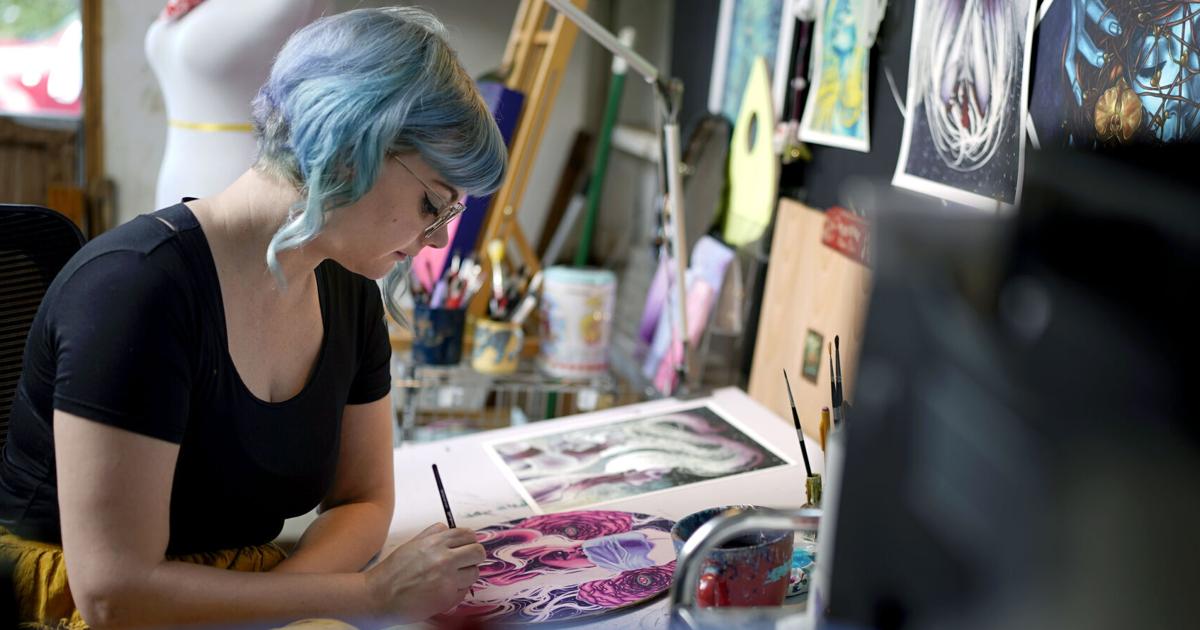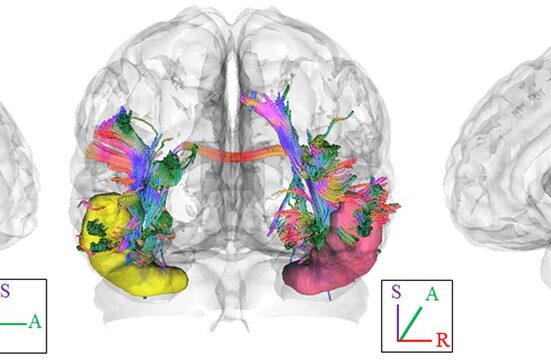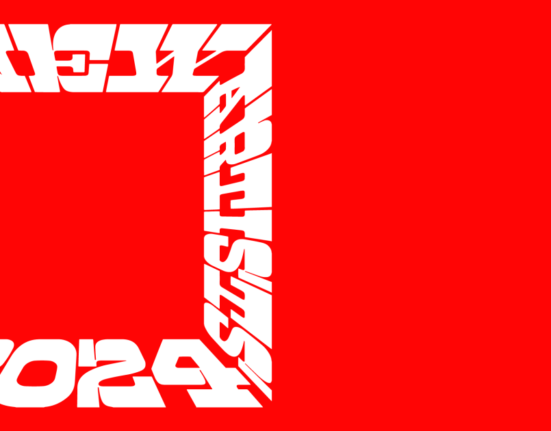NEW YORK — Kelly McKernan’s acrylic and watercolor paintings are bold and vibrant, often featuring feminine figures rendered in bright greens, blues, pinks and purples. The style, in the artist’s words, is “surreal, ethereal … dealing with discomfort in the human journey.”
The word “human” has a special resonance for McKernan these days. Though it’s always been a challenge to eke out a living as a visual artist — and the COVID-19 pandemic made it worse — McKernan now sees an existential threat from a medium that’s decidedly not human: artificial intelligence.
It’s been about a year since McKernan, who uses the pronoun they, began noticing online images eerily similar to their own distinctive style that were apparently generated by entering McKernan’s name into an AI engine.
The Nashville-based McKernan, 37, who creates both fine art and digital illustrations, soon learned companies were feeding artwork into AI systems used to “train” image-generators — something that now threatens the livelihood of artists worldwide.
People are also reading…
“People were tagging me on Twitter, and I would respond, ‘Hey, this makes me uncomfortable. I didn’t give my consent for my name or work to be used this way,'” the artist said. “I even reached out to some of these companies to say ‘Hey, little artist here, I know you’re not thinking of me at all, but it would be really cool if you didn’t use my work like this.’ And, crickets, absolutely nothing.”
McKernan is now one of three artists who are seeking to protect their copyrights and careers by suing makers of AI tools that can generate new imagery on command.
The case awaits a decision from a San Francisco federal judge, who voiced some doubt about whether AI companies are infringing on copyrights when they analyze billions of images and spit out something different.
“We’re David against Goliath here,” McKernan says. “At the end of the day, someone’s profiting from my work. I had rent due yesterday, and I’m $200 short. That’s how desperate things are right now. And it just doesn’t feel right.”
The lawsuit may serve as an early bellwether of how hard it will be for all kinds of creators — Hollywood actors, novelists, musicians and computer programmers — to stop AI developers from profiting off what humans made.
The case was filed in January by McKernan and fellow artists Karla Ortiz and Sarah Andersen, on behalf of others like them, against Stability AI, the London-based maker of text-to-image generator Stable Diffusion. The complaint also named another popular image-generator, Midjourney, and the online gallery DeviantArt.
The suit alleges that the AI image-generators violate the rights of millions of artists by ingesting huge troves of digital images and then producing derivative works that compete against the originals.
The artists say they are not inherently opposed to AI, but they don’t want to be exploited by it. They are seeking class-action damages and a court order to stop companies from exploiting artistic works without consent.
Stability AI declined to comment. In a court filing, the company said it creates “entirely new and unique images” using simple word prompts and its images don’t or rarely resemble the images in the training data. “Stability AI enables creation; it is not a copyright infringer,” it said.
Midjourney and DeviantArt didn’t return emailed requests for comment.
Much of the sudden proliferation of image-generators can be traced to a single, enormous research database: the Large-scale Artificial Intelligence Open Network, or LAION, run by a schoolteacher in Hamburg, Germany.
Christoph Schuhmann said he has no regrets about the nonprofit project, which is not a defendant in the lawsuit and largely escaped copyright challenges by creating an index of links to publicly accessible images without storing them. Still, the educator said he understands why artists are concerned.
“In a few years, everyone can generate anything — video, images, text. Anything that you can describe, you can generate it in such a way that no human can tell the difference between AI-generated content and professional human-generated content,” he said.
The idea that such a development is inevitable was at the heart of a U.S. Senate hearing in July in which Ben Brooks, head of public policy for Stability AI, acknowledged artists are not paid for their images.
Hawaii Democratic Sen. Mazie Hirono asked Ortiz whether she had ever been compensated by AI makers.
“I have never been asked. I have never been credited. I have never been compensated one penny, and that’s for the use of almost the entirety of my work, both personal and commercial, senator,” she replied.
Ortiz, also 37, of San Francisco, is a concept artist and illustrator in the entertainment industry. Her work has been used in movies including “Guardians of the Galaxy Vol. 3,” “Loki,” “Rogue One: A Star Wars Story,” “Jurassic World” and “Doctor Strange.” In the latter, she was responsible for the design of Doctor Strange’s costume.
Why, she asked, would employers pay artists’ salaries if they can buy “a subscription for a month for $30” and generate anything using AI?
“It’s overnight an almost billion-dollar industry,” she said. “They just took our work, and suddenly we’re seeing our names being used thousands of times, even hundreds of thousands of times.”
In at least a temporary win for human artists, a federal judge in August upheld a decision by the U.S. Copyright Office to deny someone’s attempt to copyright an AI-generated artwork.
Which industries are adopting AI the most and least?
Which industries are adopting AI the most and least?
Are the robots taking over, or is AI just hype? Although different sectors of the economy have been using AI for years, everyone’s talking about AI these days. The hype is partly due to the public release of ChatGPT, which has allowed people to use AI in their daily lives and understand how it can better help them.
One key thread running through this topic is how AI will change the world of work, but that can only happen with widespread AI adoption. Magnifi, an AI investing platform, analyzed data from McKinsey and Stanford University’s Institute for Human-Centered Artificial Intelligence to illustrate how AI has been deployed across the economy over the last year and its implications for individual businesses. All industry adoption rates are year-over-year changes based on responses from individual companies surveyed within those industries detailing how they’re adopting AI and for what functions.
Across all industries, American firms reported a 2 percentage-point increase in adoption of AI technologies in 2022 compared to 2021, according to McKinsey survey data. Strategy and corporate finance led all other functions for adoption across all industries in 2022, which could be symbolic of the difficult economic conditions that surfaced in the last year, forcing companies to tighten belts and sometimes lay off staff.
While industry adoption may be increasing, not every company has hopped on the AI bandwagon—just over half of companies are using AI, according to McKinsey.
Those that aren’t adopting AI could find themselves at a competitive disadvantage. According to Michael Chui, partner at McKinsey Global Institute, companies embracing AI and committing to building their capabilities will benefit from cost savings and increased revenues.

AI adoption plateaued in 2022, but half of all organizations use these 4 AI capabilities most
Companies leverage AI in numerous ways, and according to McKinsey’s survey, companies have increased the number of AI tools they’ve deployed on average from 1.9 in 2018 to 3.8 in 2022.
The most popular tool is robotic process automation, or software capable of doing repetitive tasks, used by nearly 2 in 5 companies. Thirty-four percent of companies use computer vision, a field of AI that understands and can extract data from visual input like images and video.
Rounding out the top four capabilities, at 33% implementation, are natural-language text understanding and virtual agents and conversational interfaces. These two fields could become more popular as the AI models get more robust. For example, OpenAI’s GPT-3, released in June 2020, was trained on about 100 times more data than its GPT-2, released a year earlier. And GPT-4, released in March 2023, was reportedly trained on at least 10 times more data than that.
Tech and telecom businesses saw a 22 percentage-point rise in AI adoption for risk management
One of AI’s strengths is its ability to sift through and process mass amounts of data. For tech and telecom companies, this can help them assess and manage risk by quickly detecting cybersecurity threats and data breaches and mitigating them.
But information technology professionals also worry about potential AI weaponization. A 2023 BlackBerry survey found that over half of IT professionals believe AI could assist in successful cyberattacks. That’s driving the sectors’ investment in AI tools to manage risk. BlackBerry found that at least 4 in 5 IT decision-makers plan to adopt more AI-driven cybersecurity tools.
Business, legal, and professional services companies saw AI adoption increase 11 percentage points for strategy and financial operations
Business, legal, and professional services companies are putting more money into ways AI can optimize strategy and accounting. Still, they have decreased their investments in marketing and sales AI tools by 19%. A June 2023 Thomson Reuters study found that while nearly 4 in 5 responding professional services firms thought AI could help their business operations, only 4% were actually using it.
Not helping AI’s case was the hot water two New York attorneys found themselves in after discovering that a legal brief they submitted in court included fictitious cases generated by ChatGPT. The two were sanctioned in court and ordered to pay a $5,000 fine. However, that incident hasn’t deterred some firms from taking the AI plunge: Accounting firm PricewaterhouseCoopers announced in 2023 it was using AI in its legal department and plans to find ways for its accountants to use it too.
Health care and pharmaceutical companies increased AI adoption in risk management by 9 percentage points
AI has been transforming the health care and pharmaceutical industries for several years. Johnson & Johnson and Moderna even leveraged AI tools to develop their COVID-19 vaccines.
Generative AI is helping doctors process their patient documentation more quickly. AI can also quickly analyze patient and insurance claims data, but companies must ensure patient privacy and data remain secure. Damian Chung, business information security officer at Netskope, told BankInfoSecurity.com that health care companies face risk in third-party AI tools learning from their data and using it for other customers.
Product developers and marketing and sales professionals see increasing opportunity to leverage AI beyond 2023
In terms of increasing revenues, companies are getting the most bang for their buck when using AI in product development, marketing, and sales functions. McKinsey’s 2022 AI survey found that 7 in 10 respondents earned more money using AI in these functional areas. AI tools are helping companies quickly analyze customer buying habits and create more customized marketing messages.
AI can also shorten product development cycles. In one example, PepsiCo Chief Strategy and Transformation Officer Athina Kanioura told FoxBusiness.com that AI has shortened the company’s product development cycle from years to months because it can quickly analyze consumer trends. The analysis led the company to create a new seaweed snack in less than a year.
Data reporting by Dom DiFurio. Story editing by Jeff Inglis. Copy editing by Paris Close. Photo selection by Abigail Renaud.
This story originally appeared on Magnifi and was produced and distributed in partnership with Stacker Studio.






